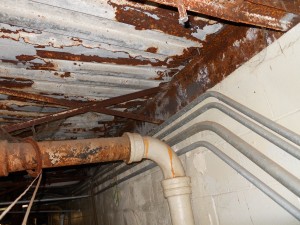Thanks to Bob Padgett, PE of Padgett Engineering Group (www.padgettengineering.com) for assistance with this posting.
Manufacturing facilities are focused on production and it seems non-process building components are a low maintenance priority. As facilities get some years on them, there are some basic building components that should be reviewed periodically.
One such component is a metal roof deck. It’s an important structural element (diaphragm) that does more than support your roof – it also provides important lateral bracing for your building structure. It is frequently loaded and unloaded by wind and rain, and is often covered by a ceiling or above bright lights making visual inspection a challenge. When first installed, the roof deck is usually either prime painted or galvanized giving it some basic protection from rust. However, many manufacturing plants are relatively harsh environments and we see a lot of metal deck damage. Often, the damage is severe enough to be a concern.

When you hear of roof collapses, it’s usually when it’s raining. These types of collapses can begin as metal deck failures due to damage from rust, structural overloading from added equipment, or “beyond design weather events”. Once roof deck or structural support failure begins, which may not be sudden or particularly noticeable, the local area sags encouraging water to pond. The increased ponding compounds the overloading and sudden collapse can occur. Nothing stops production like a hole in the roof – not to mention the life safety aspect of such an event.
If you have a facility with a metal roof deck, part of your preventive maintenance program should be the periodic inspection of the roof immediately after a rain to look for areas of ponding. If ponding is found, look for the cause, including inspection of metal roof deck and structure below, and make the necessary repairs. If the cause is not obvious, like a clogged roof drain, consult a structural engineer for an assessment and recommendations. He’s a lot cheaper than the lost time, possible injuries, and repair costs of a collapsed roof.
